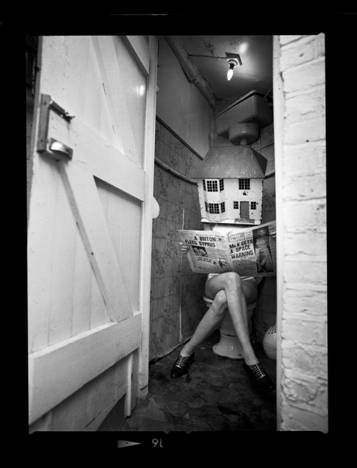Charlotte Colbert
dal 27/11/2013 al 11/12/2013
Segnalato da
27/11/2013
Charlotte Colbert
Gazelli Art House (new location), London
A day at home, the new show of London based photographer and screenwriter. The new series playfully explores the relationship between the imagined and the real within the context of the home.

A day at home, the new photographic series by Charlotte Colbert,
playfully explores the relationship between the imagined and the real
within the context of the home. She loosely parallels the writer and the
housewife as figures struggling to distinguish between the two. Their
identities dissolving within the huis-clos of their setting and
imaginings. The black and white images, shot on medium format film and
shown within the context of their original negative, are like surreal
fragments of a dream or nightmare. Using long and double exposures as
well as props and distorting mirrors, her camera becomes a portal into
the mind of a fictional character.
With playful nods to Bourgeois' "femme-maison", the visuals of ruins and
fairy tales, Colbert questions the daily insanity of being human, more
specifically within the context of the home. Shot on location, in a
derelict house in Bethnal Green, the ruins become a character in
themselves, the murky mindscape from which one cannot escape.
Drawing from her screenwriting, Colbert's photographic work is strongly
anchored within the language of film and story-telling. Her pictures
originally conceived as a series, a sequence developed in script format
before being shot. A Day At Home builds on the story-telling language of
her work. A very personal exploration of the relationship between the
writer and the home, the real and the imagined, identity and the self. A
study of madness, the fragility of our sense of existence, reality and
belonging. The writer and housewife coming together in their sense of
isolation, solitude and confinement within a space which both closes in
on them but also opens up into an epic landscape of surreal imaginings.
Here, the use of medium format film allows for the character to be
overwhelmed, defined and even disappear in her surroundings. Only a
couple of images are shot in 35mm, the ones exploring the relationship
and the mystery of self-perception, the woman's body rendered grotesque
as the viewer is placed between the character and her reflection.
"A truly original visual storyteller her images are hauntingly evocative" Laura Bailey, Vogue
"Some photographers take pictures and others make them. Charlotte is
most definitely in the second category, her pictures a gateway into...
her search for meaning and her very special way of seeing" Dorothy Bohm,
photographer and co-founder Photographers' Gallery in London
"Sometimes it feels like the thread linking us to the world is so frail
that at any time it could break leaving us at the mercy of all our
repressed confusion loss and fear" Charlotte Colbert
"When I see the pictures I feel the woman is probably sitting in her
clean and comfortable living room. The decay around her is existing
solely in her head" Mila Askarova. Director Gazelli Art House
Charlotte Colbert's work will also feature in the British Heart
Foundation's Tunnel of Love auction in November 2013. Her work Lips
Study will be sold for the charity alongside other lots including prints
by Damien Hirst and Sir Peter Blake as well as Cartier jewellery and
clothes by fashion house Mulberry.
She has developed a distinctive narrative to her work, which can be
followed from her large-scale triptychs, to her film-noir series and her
more recent medium format stills.
In her first solo show, Stornoway, shown at the Wilmotte and Tristan
Hoare Gallery in the old Lichfield Studios, she explored the concept of
narrative within the still image, building around the sequencing of
images in order to express a space and a time. She used traditional 35mm
black and white film and showed the pictures within the negative,
questioning the way one looks at photography and contextualising it as a
record of events and patterns in the greater sequence of meaning. By
turning the image around and leaving the negative apparent, she aims to
allow the viewer to re-acquire the moment at which the photograph was
taken and make the memory their own.
She then developed a series: D.R.I.F.T., an acronym for Do Reflections
Imagine For Themselves? shown at Proud Gallery and at Gazelli Art House
in which she created a loose film noir sequence within the gallery
space, giving the viewer clues to construct and imagine a narrative of
their own.
Opening Thursday 28th November 2013 18 - 21h
Gazelli Art House
39 Dover Street, Mayfair, London
Open hours: from Monday to Friday 10-18h, Saturday 11-19 and Sunday by appointment



